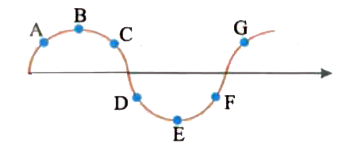A tuning fork is considered as a source of an acoustic wave of a single frequency as marked on its body.
The tuning fork cannot produce any of its harmonics due to its special nature of construction.
Statement I is true, Statement II is true: Statement II is a correct explanation for statement I.
Statement I is true, Statement II is true, Statement II is NOT a correct explanation for Statement I.
Statement I is true, Statement II is false
Statement I is falce: Statement II is true
The correct Answer is:A
The tuning fork does produce harmonics, but the intensities of the harmonics are too weak to be effective, due to its special ditribution of mass and the use of prongs.
Topper's Solved these Questions
- SOUND WAVES AND DOPPLER EFFECTBook:CENGAGE PHYSICSChapter:SOUND WAVES AND DOPPLER EFFECTExercise:Comprehension
Explore 144 Videos
- SOUND WAVES AND DOPPLER EFFECTBook:CENGAGE PHYSICSChapter:SOUND WAVES AND DOPPLER EFFECTExercise:Integer
Explore 16 Videos
- SOUND WAVES AND DOPPLER EFFECTBook:CENGAGE PHYSICSChapter:SOUND WAVES AND DOPPLER EFFECTExercise:Multiple Correct
Explore 44 Videos
- RIGID BODY DYNAMICS 2Book:CENGAGE PHYSICSChapter:RIGID BODY DYNAMICS 2Exercise:Interger
Explore 2 Videos
- SUPERPOSITION AND STANDING WAVESBook:CENGAGE PHYSICSChapter:SUPERPOSITION AND STANDING WAVESExercise:Comprehension Type
Explore 5 Videos
Similar Questions
A source of sound with adjustable frequency produces 2. beats per second with a tuning fork when its frequency is either 476 Hz or 480 Hz. What is the frequency of the tuning fork ?
View SolutionTwo tuning forks when sounded together give 8 beats per second. When tuning fork A is sounded with air column of length 37.5 cm closed at one end, resonance occurs in its fundamental mode. Tuning fork B gives resonance with air column of length 38.5 cm and is closed at one end in its fundamental mode. Find the frequencies of tuning forks.
View Solution
Knowledge Check
When a tuning fork was struck and brought near a bucket of water, a wave as shown in figure was formed on its surface. If the fork is struck much harder and brought near the surface, what will increase ?
 AFrequencyBWavelengthCVelocityDAmplitude
AFrequencyBWavelengthCVelocityDAmplitudeA tuning fork vibrates with 2 vibrations in 0.4 seconds . Its frequency ( in Hz ) is
A5B6C8D0.8Statement I : The pitch of the sound wave depends upon its frequency.
Statement II: The loudness of the sound wave depends upon its amplitude.ABoth the statements are individually true and Statement II is the correct explanation of Statement IBBoth the statements are individually true but Statement II is not the-correct explanation of Statement ICStatement I is the true but Statement II is falseDStatement I is false but Statement II is true
Statement 1: A tuning fork of constant frequency sends sound waves in air. If temperature of the air increases, then the wavelength of sound wave in air decreases.
Statement 2: Speed of sound in air increases with increases in temperature of air
View SolutionStatement I: A body weighs less on a hill top than on earth's surface even though its mass remains unchanged.
Statement II: The acceleration due to gravity of the earth decreases with height.
View SolutionSTATEMENT-1 : Beats will be heard if a tuning fork is sounded along with a sonometer wire with the same fundamental frequency as the tuning fork
because
STATEMENT -2 : Beats are caused by alternate constructive and destructive interference between two sounds.
View SolutionThe fundamental frequency of a closed pipe, if its first overtone is unison with a tuning fork of 480 Hz is
View SolutionTransverse waves are produced in a long string by attaching its free end to a vibrating tuning fork. Figure shows the shape of a part of the string . The points in phase are

View Solution

